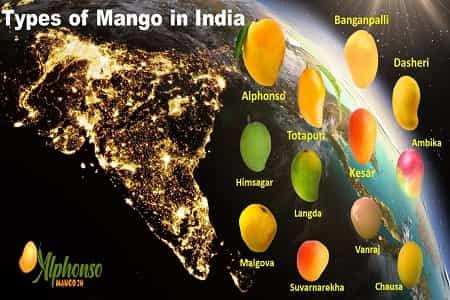- The best mangoes in South India come from Telangana, Karnataka, and Andhra Pradesh. The top varieties are Imam Pasand and Neelam.
- Imam Pasand mangoes have a royal history and turn mottled green when ripe. Neelam mangoes are large, yellow, and aromatic.
- India is a leading mango producer and exports to countries like the U.S., U.K., and Singapore.
Table of contents
How many types of mangoes are found in India?
Mangoes are a universal favourite summer fruit due to their exquisite sweetness, enticing aroma, attractive yellow colour, and many benefits.
Types of Mangoes in India
Mango is renowned as the King of fruit!

Types of Mangoes
India has more than 1,000 types of mangoes, including local varieties spread throughout the jungle.
But are you aware that multiple varieties of mangoes exist?
There are as many as 24 varieties of mangoes in India. Today, let's take a look at a few of them.
1. Alphonso Mangoes
The Portuguese first brought Hapus to India in the 1500s, and there has been no looking back.
Hapus not only assimilated into the Indian Mangoes culture but became an inseparable part of our lives.
We devour and cherish Hapus for its saffron-yellow hue, distinctly sweet aroma, and incredible flavour.
Not only is Alphonso the best of all Indian mangoes, but it is also the King of mangoes!
Alphonso mango grows exclusively in the Devgad and Ratnagiri districts of Maharashtra's Konkan coastal strip.
Konkan's volcanic soil and topography add to Alphonso's distinct flavour.
Alphonso is one of the best mangoes grown in India
2. Kesar Mangoes
The best Kesar mangoes are grown at the foothills of the famous Girnar Hills of the Junagadh district, Gujarat. Kesar translates to Saffron in English.
Therefore, these are called Kesar because of their Saffron colour and exquisite taste.
Kesar mangoes are so delectable that some call them the Queen mango!
Kesar mangoes are medium-sized, round, and have a distinct curve, which makes Kesar easily recognizable.
3. Totapuri Mangoes
Also known as Ginimoothi, Totapuri mangoes are extensively grown in South India.
Totapuri mangoes from Bangalore are particularly famous for their distinct shape. Their shape resembles a parrot's beak.
The name Ginimoothi stems from their form, with Gini meaning parrot and Moothi meaning beak.
Totapuri mango is indeed a unique mango found in India exclusively.
4. Himsagar Mangoes
Popularly known as Khirsapati, Himsagar mangoes are extensively grown in the Chapai Nawabganj, Murshidabad, Hooghly, and Malda districts of West Bengal.
Himsagar Mangoes are the most non-fibrous mangoes and have an excellent shelf life. A medium-sized Himsagar mango weighs approximately 250-350 grams.
The most exciting part of Himsagar mangoes is that 77% of the fruit is pulp. Thus, They are a delicious, pulpy treat!
4. Dasehri mangoes
One of the most beloved mangoes cultivated in north India is the Dasehri mango.
Known for its sweet and exquisite taste, the Dasehri, grown in Malihabad, Uttar Pradesh is regarded as the best!
Despite its humble beginnings in Kakori, Uttar Pradesh, Dasehri gained popularity when it started growing in the gardens of the Nawab of Lucknow.
Dasehri is a small-sized mango with an aroma and flavour that's second to none.


5. Imam Pasand and Neelam Mangoes
The best mangoes produced in South India are those grown exclusively in Telangana, Karnataka, and Andhra Pradesh. Telangana Imam Pasand and Neelam mangoes are the best.
Imam Pasand is known locally by multiple names, such as Hamam, Himayat, and Himam Pasand.
The name Imam Pasand suggests a royal lineage, and estimations indicate that mangoes were a hot favourite among royals.
Imam Pasand takes on a mottled green hue as it ripens.
Neelam mangoes are oblong and huge. They have an enticing herbaceous aroma, an attractive yellow hue, and a pointed base.
India is one of the biggest mango producers globally, and an increasing number of mangoes are exported to the United States, the United Kingdom, Singapore, and many other countries.
Indeed, mangoes make India proud!
Buy Alphonso Mango online in Bhubaneshwar.
Conclusion
In conclusion, the types of mangoes available around the world offer a wide variety of flavours, textures, and colours. From the sweet and creamy Alphonso to the aromatic and tangy Neelam, each type has its own unique appeal. Whether eaten fresh, blended into smoothies, or used in desserts, the types of mangoes cater to different tastes and preferences, making mangoes a favourite fruit worldwide.
What are the most popular types of mangoes?
Some popular types include Alphonso, Tommy Atkins, Haden, Kent, and Keitt. Each variety has a unique taste, texture, and colour.
Which mango is the sweetest?
Alphonso mangoes are considered the sweetest, with a rich, creamy texture and intense aroma. Other sweet varieties include Honey (Ataulfo) and Kesar mangoes.
How do I choose the best mango?
Look for mangoes that feel slightly soft when gently squeezed. The skin colour varies by type, so focus on ripeness rather than colour. A fruity aroma near the stem is a good sign of a ripe mango.




